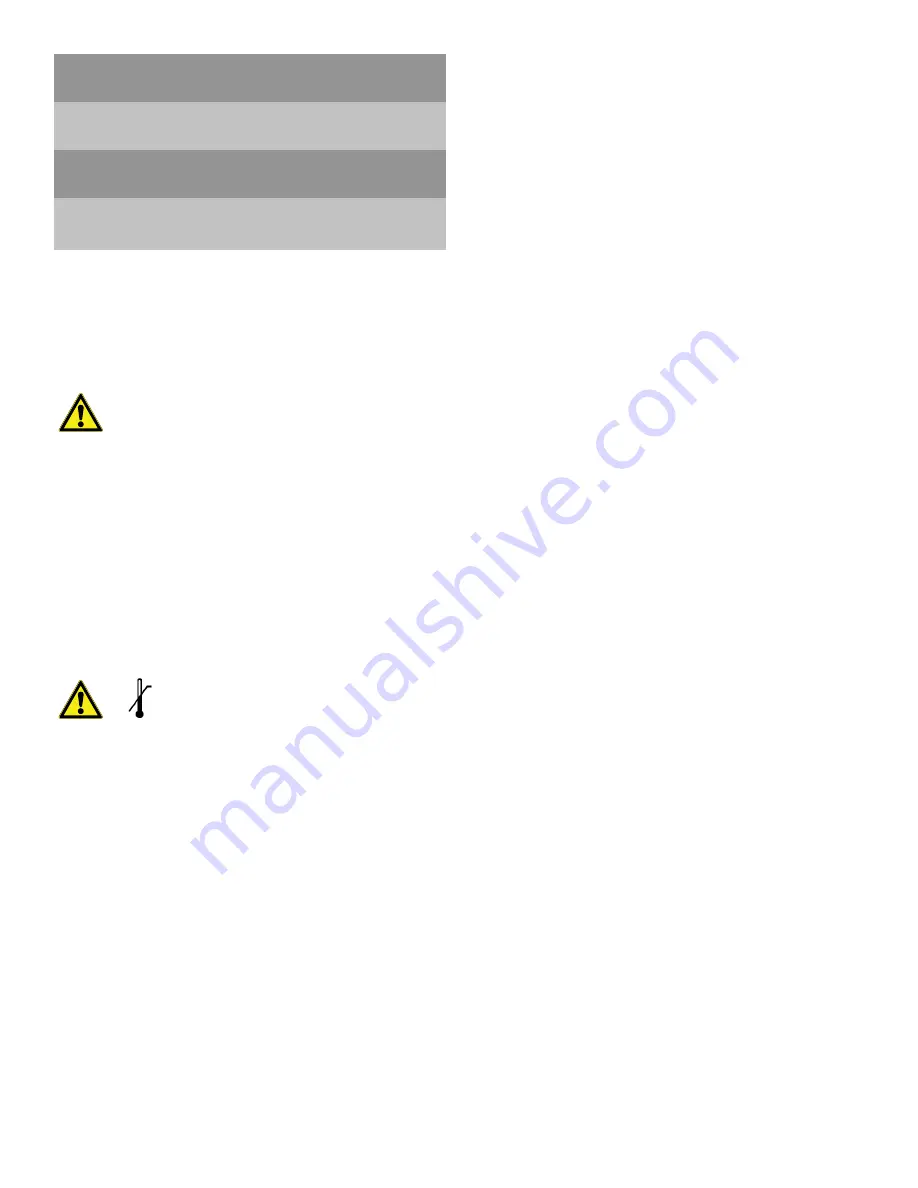
2 | Safety and First Aid
Thermo Fisher Scientific CryoExtra CE8100 Series
Liquid Nitrogen Safety
Transferring LN
2
and operating the Controller should be done
in accordance with the manufacturer/supplier instructions. It
is important that all safety precautions written on the storage
Dewar and recommended by the manufacturer be followed.
The two most important safety aspects to consider when
handling LN
2
are adequate ventilation and eye and skin
protection. Although nitrogen gas is non-toxic, it is dangerous
in that the gas will displace oxygen in a normal breathing
atmosphere. Liquid products are of even greater threat since
a small amount of liquid evaporates into a large amount of
gas. Therefore, it is imperative that cryogenic supply and
storage Dewars be stored and operated in well-ventilated
areas.
Persons transferring LN
2
should make every effort to protect
the eyes and skin from accidental contact with liquid or cold
vapor. Thermo Fisher Scientific recommends the following
protective clothing and accessories when transferring LN
2
or
handling hoses, valves and plumbing components:
Recommended protective clothing
•
Cryogenic gloves (loose fitting)
•
Full-face shield or chemical splash goggles
•
Cryogenic apron
•
Long sleeve shirt and cuff less pants
•
Closed toe shoes (no sandals)
Equipment Usage
Cryogenic containers must be operated in accordance with
the manufacturer / supplier instructions. Safety instructions
will also be posted on the side of each Dewar. Cryogenic
containers must be kept in a well-ventilated area protected
from weather and away from heat sources.
In applications that use a modular liquid cylinder as a source
of LN
2
, the supply will need to be replenished at regular
intervals to ensure proper operation of the freezer. When
exchanging liquid cylinders, follow the below procedure:
1. Allow all plumbing components to warm to room
temperature before attempting to change supplies.
2. Close all valves associated with the liquid supply cylinder.
3. Relieve pressure in the plumbing assembly by initiating a
brief fill by either pressing “Start Fill” or using the manual
fill button.
4. Loosen the plumbing connection for the transfer hose at
the liquid cylinder.
5. Remove empty liquid cylinder and replace with full liquid
cylinder pressurized to 22 – 35 psig (1.52 - 2.41 bar).
6. Attach the transfer hose to the plumbing connection on
the liquid cylinder. Ensure that the hose is connected to
the connection labeled “LIQUID”.
7. Tighten the transfer hose plumbing connection at the
liquid cylinder.
8. Open the liquid supply valve on the liquid cylinder.
9. Inspect plumbing for audible and visual leaks. Request
repair if necessary.
10. Manually initiate a fill to verify proper operation.
Boiling Point @ 1 atm
-195.8°C , -320.3°F,
77.4 K
Thermal Conductivity
(Gas)
25.83 mW/(m.K)
Heat of Vaporization
(Liquid)
198.38 kJ/kg
Density @ 1 atm (Liquid)
1.782 lbs/L , 807.4 g/L ,
808.6 kg/m
3
WARNING: Do not modify this equipment
without authorization of the manufacturer.
•
Nitrogen is a potential asphyxiant and
can cause rapid suffocation without
warning. Store and use in area with
adequate ventilation. Do not vent
container in confined spaces. Do not
enter confined spaces where gas may be
present unless area has been well
ventilated. If inhaled, move to fresh air. If
breathing is difficult, supplemental
oxygen may be required. If not breathing,
give artificial respiration. SEEK MEDICAL
ATTENTION IMMEDIATELY!
•
Liquid nitrogen can cause severe
frostbite to the eyes or skin. DO
NOT touch frosted pipes or
valves. Cold nitrogen vapor can
damage the eyes or skin. In case
of frostbite, consult a physician
at once. If a physician is not
readily available, warm the
affected area with water that is
near body temperature.
•
Never place LN
2
in a sealed
container without a pressure
relief device. The expansion ratio
of liquid nitrogen to gaseous
nitrogen is approximately 1 to
700 (i.e. 1 cubic foot of LN
2
becomes 700 cubic feet of gas
when evaporated).







































